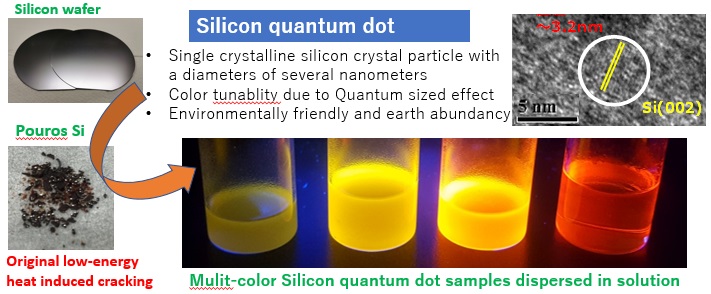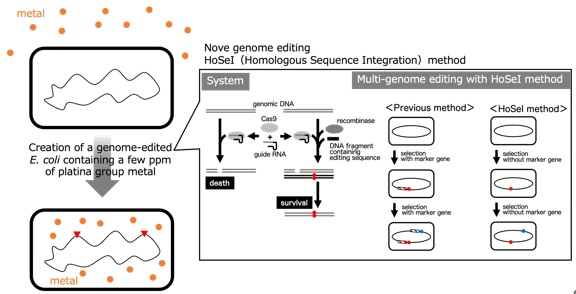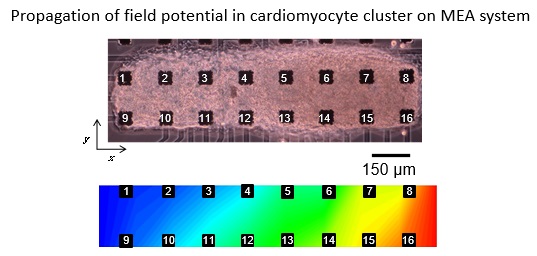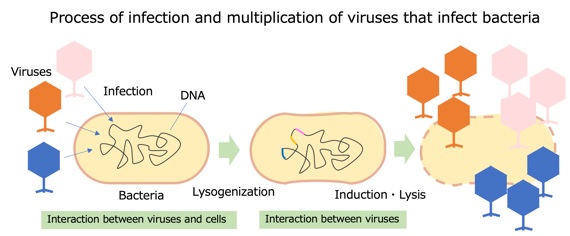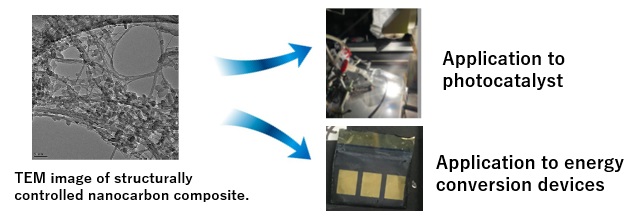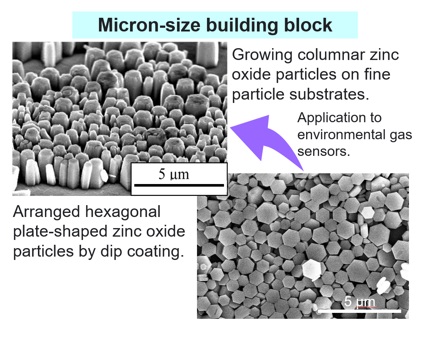3D advanced material processes contributing to the realization of a post-corona sustainable society
The mission of our university is to contribute to the "construction of a sustainable global society" by resolving the diverse challenges of the turbulent 21st century. Aiming to develop new technologies that respond to social changes triggered by global environmental issues such as global warming, which has become a real crisis, and the response to the novel coronavirus, which has forced our nonroutine daily lives. Utilizing and further developing many seeds that have been created in the past projects of our research center, and gathering new interdisciplinary wisdom, we will solve energy problems, and make effective use of limited resources to realize a sustainable society where industrial development and livable society are in a balanced manner.
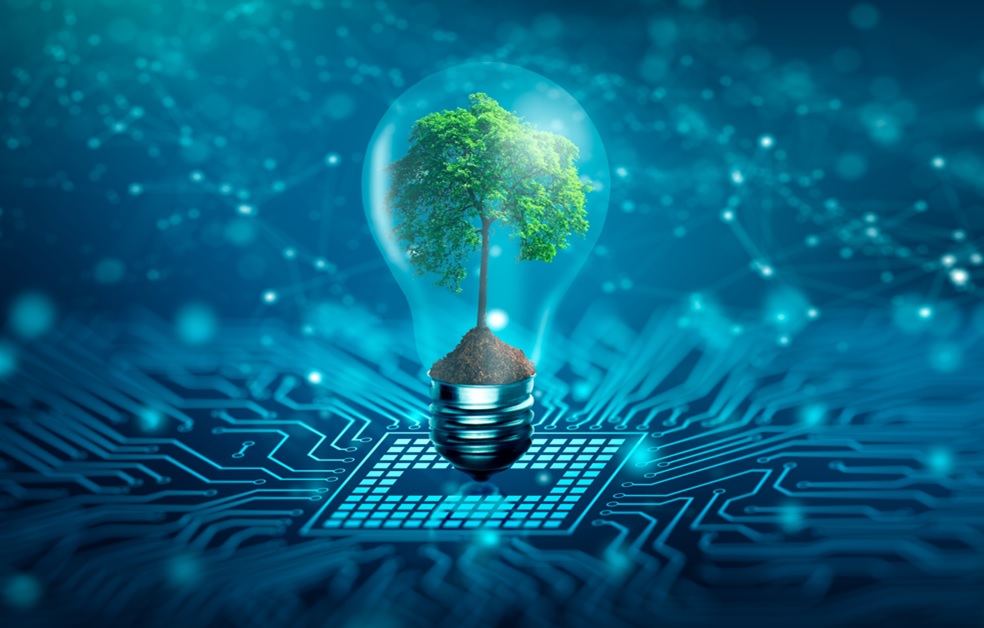
1.Realization of high functional smart machine parts by multi-material 3D printing (Gaku MINORIKAWA)
2.Design of slant direct drive parallel mechanism for additive printing system (Yutaka TANAKA)
3.Development of multipurpose micro turbine by application of 3D printing (Hoshio TSUJITA)
4.Multiscale structural control by 3D additive manufacturing to develop novel metal-based biomedical composites with sustainable mechanical performance (Hideaki TSUKAMOTO)
5.Low power consumption ultra-high precision motor drive system (Akira YASUDA)
6.High yield processing for fabricating environmentally friendly semiconductor quantum dot (Toshihiro NAKAMURA)
7.Development of ultra-low power neural prosthetic device (Hiroyuki TORIKAI)
8.Research on high-efficiency power conversion devices using micro-fabricated wide-band-gap semiconductors (Tomoyoshi MISHIMA)
9.Development of bioaccumulation using genome edited bacteria for metal enrichment (Kaneyoshi YAMAMOTO)
10.Reconstruction of 3D heart structure for measurement of drug response (Tomoyuki KANEKO)
11.Survival strategies of viruses infecting bacteria (Tsutomu SATO)
12.Study on regulation and stabilization of photosynthetic devices under environmental stresses (Naoki MIZUSAWA)
13.Study on the design principles of biological nanomachines (Yoshiyuki SOWA)
14.Control of electronic properties and catalytic activity of micro-nanocarbon composites (Hironori OGATA)
15.Fabrication of 3D controlled functional oxide/sulfide micro/nanostructures (Takamasa ISHIGAKI)
16.Development of Photoreactive Soft Materials (Kenji SUGIYAMA)
17.Lamination and mounting of ceramic particle layer on alloy with 3D-shaped alloys (Takaya AKASHI)
18.Recovery of carbon dioxide using nano-structure controlled layered double hydroxide (Yujiro WATANABE)
1.Realization of high functional smart machine parts by multi-material 3D printing (Gaku MINORIKAWA)
A new prototype cementitious material 3D printer with a molding range of about 1m x 1m x 1m was built、 and optimal values for the nozzle feed rate and stacking pitch were defined under conditions where the material is supplied without excess or deficiency。 Here、 we confirmed the effectiveness of the overlap stacking method、 which is based on overlap stacking where the stacking pitch is smaller than the nozzle diameter、 with respect to a method that dramatically improves stacking performance by smoothing the stacking surface as the material is collapsed。 We also proposed a stacking type resonator made of cementitious material that is effective in adjusting the frequency response in the low-frequency range by fabricating a connected Helmholtz resonator.
-

Additive method of ME type 3D printing
-

Stacking type resonator made by cementitous materia
2.Design of slant direct drive parallel mechanism for additive printing system (Yutaka TANAKA)
Recently additive manufacturing has become a main stream manufacturing process. Different additive manufacturing processes build layers in different ways. Inkjet printing has a great potential for fast and accurate response to build layers. A prototype model of six degrees-of-freedom parallel mechanism stage for the fixed head type of 3D printing system was designed and fabricated. A pillar with high aspect ratio of 10:1 was fabricated using the prototype model of the 3D printing system. A slant direct drive parallel mechanism for a prototype additive printing system with a fixed FDM head was proposed and designed. The additive manufacturing system indicated the possibility of modeling curved surfaces additively.
-

3D Printing system configuration and results of modeling experiment
3.Development of multipurpose micro turbine by application of 3D printing (Hoshio TSUJITA)
The application of 3D printing technology is spreading in the manufacturing of various type of turbomachines, which are seriously required to be improved in efficiency for the reduction of environmental load. The increase of blade loading by the increase of turning angle for an axial turbine blade facilitates the application of an air-cooling system due to the increase of blade thickness, and consequently enhances the efficiency of the micro gas turbine required to be reduced in size and weight. On the other hand, the 3D printing technology makes it possible to construct the complex configuration of air-cooling holes inside the solid blade. In this study, in order to collect the knowledge for the development of an axial turbine blade with high loading, the investigations are conducted to clarify the complex flow behavior and the loss generation mechanisms in the ultra-highly loaded turbine cascade with the turning angle of 160 degrees.
4.Multiscale structural control by 3D additive manufacturing to develop novel metal-based biomedical composites with sustainable mechanical performance (Hideaki TSUKAMOTO)
Metal-based biomedical composites to be components of biomedical implants such as artificial bones, artificial joints, dental implant etc. can be developed using 3D additive manufacturing (3D AM) techniques to control nano-, micro- and macro-structures including crystal structures, microstructural morphology, elemental distributions, as well as reaction phases reflecting biocompatibility, mechanical performance, and corrosion behavior. The complexity in the configuration fashion of such biomedical implants makes it difficult to improve the sustainability in such characteristics using uniform mechanical and thermal treatments. In this study, multiscale structural control for zirconia/ titanium alloy functionally graded materials (FGMs) are conducted using the 3D AM. In particular, solidification processes for metal-based parts are precisely controlled to develop preferable multiscale structures to construct sustainable biomedical FGMs. The processes are combined with centrifugal slurry methods, which have been investigated in our laboratory.
-

Electron microscope (SEM EDX) image (elemental mapping) of carbon nanotube (CNT)/aluminum (Al) FGMs fabricated by centrifugal slurry methods.
-

Illustration, SEM EDX image and Vickers hardness of zirconia (ZrO2)/stainless steel (SUS304) FGMs fabricated by centrifugal slurry methods.
5.Low power consumption ultra-high precision motor drive system (Akira YASUDA)
We propose a multi-coil motor that divides the internal coil of the motor and drives it individually, aiming to realize a motor system with high efficiency and low power consumption under a wide range of speeds and load conditions. In order to realize the low power consumption characteristics and high-precision drive characteristics of this multi-coil motor, a high-precision and high-efficiency drive circuit is needed. Especially for higher accuracy, we propose a new drive system with digital feedback of the output waveform and clarify its characteristics. The output waveform of the transistor, which is the drive signal of the motor, is an analog quantity, and it is necessary to convert this into a digital signal high precisely. On the other hand, low power consumption characteristics are required to improve efficiency. For this purpose, we will study the output error feedback type multi-coil motor system shown in the figure.
-

Error-feedback multi-coil motor system.
6.High yield processing for fabricating environmentally friendly semiconductor quantum dot (Toshihiro NAKAMURA)
Recently, semiconductor based-quantum dots are employed in extremely brightly display devices. The quantum dots usually consist of metal elements such as cadmium and lead. Because of the toxicity of these elements to the human, the wastes of these devices using the semiconductor quantum dots can be hazardous to the environment. To overcome this issue, we work on the development of the high yield processing for fabricating the environmentally friendly semiconductor quantum dots consisting of silicon (Si), which is earth abundant element and free to the toxicity. Resent research topics are to realize the luminescence color tunablity in wide visible spectral range through the quantum sized effect and extremely high luminesce efficiency.
7.Development of ultra-low power neural prosthetic device (Hiroyuki TORIKAI)
Neural prosthesis devices are used to restore neural functions which are lost by disease or accidents. Typical examples of the neural prosthesis device are cochlear implant and hippocampal implant. This research project aims at achieving a post-COVID19 sustainable society by developing ultra-low power neural prosthetic devices. In particular, this project developpes very-large-scale integration (VLSI) circuits that can reproduce excellent functions of animals and humans. For example, ultra-low power VLSI circuits that can reproduce complicated nonlinear sound processing functions of mammalian cochleae are developed. In addition, ultra-low power VLSI circuits that can reproduce nonlinear information processing functions of mammalian neuron networks are developed.
-
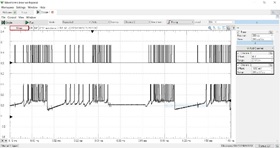
Typical time waveforms of an ultra-low power artificial VLSI neuron.
8.Research on high-efficiency power conversion devices using micro-fabricated wide-band-gap semiconductors (Tomoyoshi MISHIMA)
Power devices using gallium nitride (GaN) have been proven to have higher power conversion efficiencies than those using conventional silicon and silicon carbide, and are expected to make a significant contribution to a low-carbon society. In this research, we develop a power diode which has a low turn-on voltage, low forward resistance, and high reverse breakdown voltage by adopting a vertical structure that is particularly advantageous for high performance in GaN power devices. We conduct research toward the realization of the above goals by micro-fabricating ultra-high-concentration Mg-doped p-type GaN layers that have been thinned to the nano-size level processing into concentric circles.
-
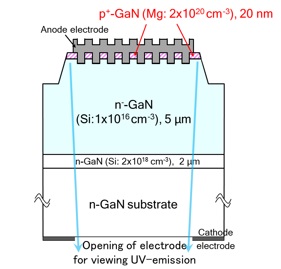
Schematic image of GaN MPS(Merged PiN Schottky) diode
-
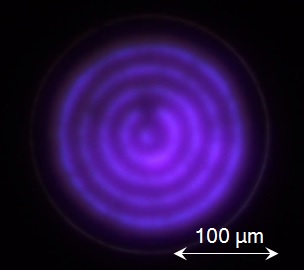
Light emission under forward-biased conditions (Ultraviolet light is emitted from the multiple- ring-shaped PN diode part)
9.Development of bioaccumulation using genome edited bacteria for metal enrichment (Kaneyoshi YAMAMOTO)
For industrial metals, minerals (Generation 1) and waste (Generation 2) are used as resources. We have not developed technology to isolate industrial metals from resources containing little metals: e.g. valuable metal-containing industrial effluents (Generation 2.5) or soil, sea water, and fresh water (Generation 3). Our efforts have created a genome-edited E. coli containing a few ppm of platina group metal. This is available to construct novel system to create industrial metals from unutilized less than ppm of valuable metal in Generation 2.5 and 3 resources.
10.Reconstruction of 3D heart structure for measurement of drug response (Tomoyuki KANEKO)
Heart is an important organ having a function to pump blood to other organs. In advanced medical care such as cardiomyocyte sheets, it is difficult to show the equal function of heart owing to random cell arrangement. Therefore, using an agarose microchamber and 1 cell arrangement technology, we will try to reconstruct the 3D heart having the equal function of real heart. Using this reconstructed 3D heart to measure extracellular potentials with high temporal resolution on a multi-electrode array (MEA) system, we aim to record a drug response equivalent to the real heart.
11.Survival strategies of viruses infecting bacteria (Tsutomu SATO)
Viruses are nanoparticles that include genetic materials, such as DNA. Viral infections cause damage to not only the organisms but also their communities. The goal of this study is to investigate the survival strategies of viruses in nature. To this end, we aim to elucidate virus-cell and virus-virus interactions and their mechanisms. Specifically, we will analyze 1) the infection mechanism of viruses infecting bacteria called bacteriophages, 2) the integration process of viral DNA into the host genome, and 3) the interactions between viruses in the host genomes. Currently, bacteriophages infecting a soil bacterium Bacillus subtilis, are being screened from the environment for research material.
12.Study on regulation and stabilization of photosynthetic devices under environmental stresses (Naoki MIZUSAWA)
Photosynthetic organisms are constantly exposed to various environmental stresses such as strong light, high temperature, high salt, and drought, but it is considered that they adapt to the stresses by regulating the photosynthetic activities. One of the problems for industrial application of natural photosynthetic devices is their structural instability. If their stability is improved under environmental stress such as high temperature, it can be expected that the photosynthetic devices can be applied industrially by using them isolated from the cells. In this study, we aimed, by using cyanobacteria which are oxygen-evolvingPhotosynthetic organisms, to clarify the changes in the structure and function of photosynthetic devices under environmental stresses, and to develop highly stable photosynthetic devices.
-

A large-scale culture of cyanobacterium and structure of photosystem II isolated from the cells.
13.Study on the design principles of biological nanomachines (Yoshiyuki SOWA)
By understanding the design principles of biological nanomachines with highly efficient energy conversion, we aim to contribute to realizing a sustainable global environment. The bacterial flagellar motor under study is a 50-nanometer diameter nanomachine self-assembled from numerous protein molecules. This motor can convert the chemical energy gained from ion flux to its rotation up to several hundred Hz in both directions with high-efficiency energy conversion. Our group aims to measure the dynamic properties of the motor by developing a new microscope and understand how it works. Furthermore, by manipulating motor component proteins, we will explore the possibility of adding new functions to motors, such as coupling ions that are not used in nature.
-
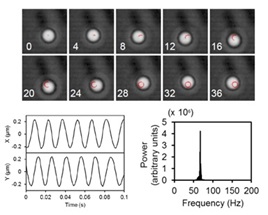
Rotation measurement of the bacterial flagellar motor by a bead assay
14.Control of electronic properties and catalytic activity of micro-nanocarbon composites (Hironori OGATA)
In this research, we aim to synthesize composites with organic-inorganic semiconductor nanoparticles by bottom-up methods using micro-nanocarbon materials with various morphologies as templates, and apply them to energy conversion materials, environmental purification materials, and photocatalytic materials. Structurally-controlled composites of carbon nanotubes with large light absorption from the near-infrared to the ultraviolet region and organic-inorganic semiconductor nanoparticles by a wet process are fabricated. We will conduct research for their application to photocatalysts and energy conversion.
15.Fabrication of 3D controlled functional oxide/sulfide micro/nanostructures (Takamasa ISHIGAKI)
Bottoming-up precursors in solution are highly controlled to fabricate micro~meso~macro-size particles and porous bodies of metal oxides and sulfides, which are expected to apply for energy-related and environmental materials. Nano-size oxide particles are functionalized by using ecofriendly mechanochemical processing. The combination of nano-sized sulfide quantum dots and porous oxide film with mesopores is applied to new energy devices, like solar cells. In addition, we are producing pseudo-single crystal thin films with highly reactive crystal faces exposed for the use of environmental gas sensors, through self-accumulation of micron-size oxide fine particles and subsequent growth of oriented structures.
16.Development of Photoreactive Soft Materials (Kenji SUGIYAMA)
Synthesis and application of the amphiphilic block copolymers functionalized with photoreactive groups will be investigated in order to develop the novel functional soft materials taking advantage of their self-assembly behavior in the selective solvent. For instance、 the functional nano-capsule will be formed by the selective decomposition of the unreacted domain. The potentially application of these nano-capsules for the development of next-generation electronic materials will be also expected to construct a perfect phase structures in which conductors and insulators are 3D-stacked at the nano level.
17.Lamination and mounting of ceramic particle layer on alloy with 3D-shaped alloys (Takaya AKASHI)
A new method to laminate and mount ceramic particle layer, sol-dropping electrophoresis deposition method, was developed and patented. In the method, sol, in which ceramic particles are dispersed in an organic solvent and metal alchoxide, is dropped in alcohol under a voltage. In the alcohol, ceramic particles are sedimented on the surface of alloy by voltage, and are solidified by the reaction of metal alchoxide and water in alcohol. Final product of ceramic particle layer can be formed by firing the sediment layer at a relatively low temperature. We successfully fabricated ceramic particle layer on the surface of bearing steel ball by the new method, and improved sliding property of the ball on stainless steel plate.
18.Recovery of carbon dioxide using nano-structure controlled layered double hydroxide (Yujiro WATANABE)
Layered double hydroxides (LDHs), which are one of the clay minerals, have the adsorption ability for various harmful substances using their layers. It is known to have the high selectivity of carbonate ions. Therefore, the recovery methods of carbon dioxide have been investigated by many researchers. The purpose of this study is to synthesize nano-structure and anionic species controlled LDH suitable for carbon dioxide recovery.
-
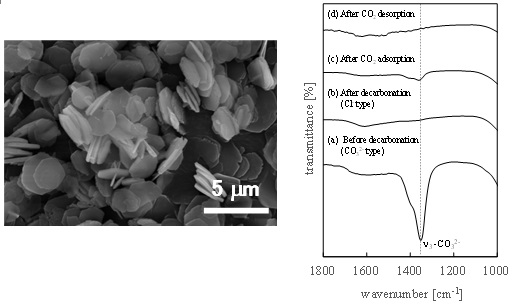
SEM image and FT-IR spectra of highly crystalline Mg-Al layered double hydroxide.



